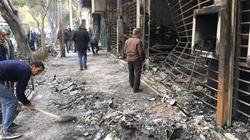 Iranian Interior Minister Abdolreza Rahmani Fazli has detailed the scale of damage inflicted on public and private property during violent riots that recently hit several cities.
Iranian Interior Minister Abdolreza Rahmani Fazli has detailed the scale of damage inflicted on public and private property during violent riots that recently hit several cities. RNA - Speaking at a program on IRIB TV1 on Tuesday, Rahmani Fazli said over 50 military bases had been targeted during the violence, while 34 ambulances, 731 banks , 140 government sites, 70 gas stations, nine religious centers, 307 private vehicles, 183 military vehicles and 1076 private motorbikes had been vandalized and torched.
The number of the injured police officers and Basij forces was twice that of the hooligans who disturbed public order, he said, adding that facts and figures testify to the high degree of restraint exercised by police forces in dealing with the rioters.
He also estimated that between 130,000 and 200,000 people had taken part in the riots nationwide.
Rahmani Fazli also noted that a number of foreign media outlets had worked to fuel the unrest, adding some even broadcast images from 2017-2018 riots in Iran and the ongoing anti-government demonstrations in Iraq to portray the situation in Iran as chaotic.
The rioters, he noted, in groups of four or five, attacked public and private property using Molotov cocktails.
The minister explained that access to the Internet was initially restricted and later shut down completely when there was an increase in acts of violence and vandalism, adding the move was meant to prevent further damage and safeguard national security.
According to Press TV, the rioters took advantage of a series of public protests that broke out in Iran on November 15 after the government announced a gasoline rationing measure.
Iran has, over the past days, arrested over 100 ringleaders and masterminds of the violent attacks.
The Judiciary has said a number of those elements were tied to the notorious US-backed Mujahedin-e Khalq Organization (MKO) terror group, royalists as well as separatists — who were nabbed in the country’s border provinces — besides members of organized groups trained towards staging acts of sabotage.
847/940